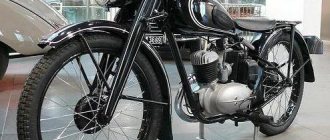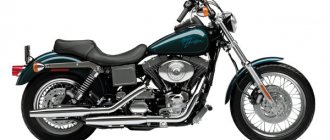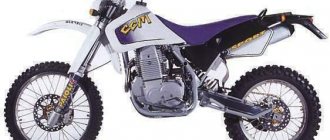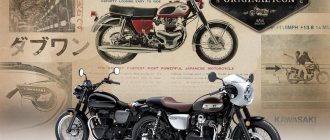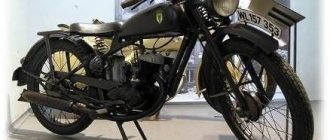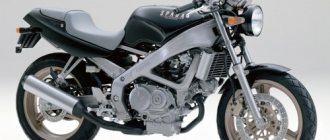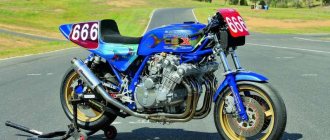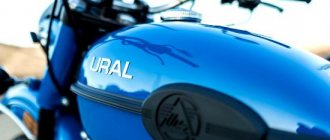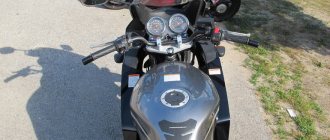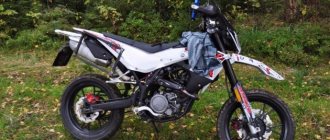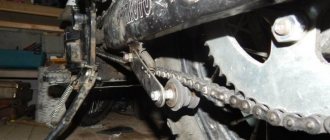Motorcycle “Kovrovets”: technical characteristics and photos
“Handsome” - this is what Soviet daredevils and connoisseurs of motorcycle technology called the K-175 model, which became fundamentally new and technically advanced back in 1957. The prototype of the famous Kovrov iron horses was the captured model of the German motorcycles DKW-RT-125. It was the best of the light motorcycles with an engine displacement of 125 cm³ from the 30s and 40s of the last century.
About the history of the development of Kovrovets motorcycle models
A year after the Patriotic War, in 1946, the first models of Kovrov motorcycles with an engine displacement of 125 “cubes” were released. The model was called “K-125”. This motorcycle was actually a complete copy of the German RT-125, of which 286 units rolled off the Degtyarev assembly lines in the first year of production.
The Kovrovets motorcycle of the 125th model was one of the best Soviet light motorcycles that were produced until 1951. Then the equipment was modernized, which consisted of improving comfort and convenience while driving. In the period from 1951 to 1955, Kovrov craftsmen produced the K-125M model.
In 1955, the management of ZiD (Kovrov plant named after Degtyarev) decided to produce fundamentally new models of motorcycles, which were supposed to differ from their predecessors in improved performance characteristics. This is how the K-55 model appeared. This Kovrovets motorcycle was equipped with a completely new type of carburetor and an upgraded exhaust gas removal system, due to which it was possible to increase its power.
The turning point 57th year
“K-55” was produced until 1957, after which another model appeared - “K-58”, on which a 5-horsepower two-cylinder engine was installed, and the gas tank was also enlarged. In addition, manufacturers changed its shape, which became more streamlined, and modernized the electrical equipment of the machine. The Kovrovets motorcycle (photo can be seen below) of the 58th model became the final one in the model range of 125 cc “bikes”, the production of which ended in 1960.
The production of Kovrov motorcycles of the K-175 series was launched in 1957. These were powerful road motorcycles, which, along with the 58th model, were produced by the plant until 1960. Later they were replaced by the K-175A model. The 175 series motorcycle was produced until 1965, and its prototype was the Czech model “Java-ChZ-175”. In the Soviet Union, motorcycles with a displacement of 175 cm³ had not previously been produced, so the appearance of the K-175 model on the market caused quite a stir.
The Czech “Java” at that time was the height of perfection in engineering and technical solutions, so the “Kovrovets” motorcycle turned out to be quite an interesting machine - beautiful and powerful, with excellent driving characteristics, and also very comfortable. The “K” series is completed by the “K-175V” and “K-175SM” models, after which the “Voskhod” (Kovrovets) motorcycle appeared in 1966 - a machine that was an order of magnitude more comfortable, which was distinguished by excellent technical characteristics.
Characteristics of the K-125 model produced in 1946-1951
“Kovrovets” 125 series is a single-seat lightweight road motorcycle, which is equipped with a two-stroke single-cylinder 4.25-horsepower air-cooled engine providing maximum power of 4.8 thousand rpm. The motor cylinder is made of cast iron, which, together with the light-alloy head, is mounted on an aluminum crankcase using studs. The engine also has a variable electric generator “G-35” and a float carburetor of the “K-30” type with a needle valve type.
The transmission of this model is presented in the form of a three-speed gearbox with foot shift. The multi-disc clutch is located in the oil sump. The tubular enclosed frame weighs just over 5kg and the total machine weight is 84kg, with the engine weighing 17.5kg. The dimensions of the base are 1245x970x675 mm. The maximum speed that this motorcycle can reach is 70 km/h. Note that in 1951 the K-125M model was released, which already weighed 88 kg. It was equipped with a front telescopic fork, which was articulated with a hydraulic shock absorber.
Series "K-55" and its features
The plant's design bureau carried out developments to modernize the 125th Kovrovets, and already in 1955 the first model K-55 was produced. Thanks to modernization, the speed characteristics of the Kovrovets motorcycle were increased to a maximum value of 75 km/h. The 55 was equipped with a new type of carburetor “K-55”, and the rear suspension became pendulum.
Previously, on the 125th model, the rear rigid suspension caused significant discomfort while riding and led to the need to repair the Kovrovets motorcycle (mainly the chassis). The car was equipped with a single-stroke 4.75-horsepower two-cylinder engine of its own production with a displacement of 123.7 cm³ and an improved cooling system. The motorcycle weighs, like the K-125, 84 kg. The Kovrovets motorcycle, model K-55, was produced by the plant until mid-1957.
About the Kovrovets 58th model
The maximum speed of the model reached 80 km/h with a total motorcycle weight of 92 kg. The displacement of the single-cylinder 5-horsepower engine remained unchanged. However, the shape of the fuel tank and its capacity were changed, which made it possible to increase mileage without the need for refueling. The clutch release mechanism was also modified, which made squeezing much easier. In addition, without loss of engine power, it was possible to significantly reduce noise by installing a muffler of a more advanced model.
The light motorcycle of our childhood. History from “Kovrovets” to “Voskhod”
We continue to reminisce with you about the motorcycles of our childhood. In the previous article we read with you how the Minsk motorcycle appeared. There was also a motorcycle very similar to it, which also needs to be remembered.
This is the Voskhod motorcycle.
He was very similar in appearance to his Minsk counterpart, as you remember. And, in principle, how they appeared is also similar.
After the end of the war, many factories were given the task of retraining and starting producing equipment that people needed in peacetime. The same task was assigned to the Kovrov plant. It bore the name of Degtyarev and produced machine guns during the war.
Therefore, 1946 was the year when, for the first time, this production produced a light domestic motorcycle, which simply received the number “K-125”. It was made on the basis of captured German drawings, therefore, like its Minsk counterpart, it was very similar to the German one. The engine of the first models had one cylinder and was two-stroke. The project to create the first such equipment for the people was led by N. Lopukhovsky.
These similar models were produced until 1957. During this time, “K-125”, “K-125M”, “K-125-S2”, “K-55” and “K-58” were released.
The year 1957 was marked by the release of the K-175 brand and a little later K-175A, K-175B, K-175V. The “B” model was equipped with a forced 9.5 horsepower engine. This model was called “Kovrovets”, and was popularly nicknamed “Kovrovskaya Java”, because it was very similar to the legendary Czech brother “Java 250”. “Kovrovets” differed in its four-speed gearbox from its predecessors, which had three stages. “Kovrovets” became the predecessor of the model that we all remember under the name “Voskhod”.
MY MOTORCYCLE
In the Soviet planned economy, “every cricket knew its nest.” Competition was not encouraged, and each enterprise had a nomenclature assigned to it. The factories in Kovrov and Minsk, which produced almost the same model of a 125 cc motorcycle, did not fit into this scheme annoyingly. And when the Kovrov residents “got promoted,” officials breathed a sigh of relief.
The epochal 20th Congress of the CPSU went down in history by condemning the cult of personality. And techies have their own milestones. Firstly, at this congress it was decided to stop the production of steam locomotives. Secondly, at the exhibition of industrial products, presented for review by participants, the first truly new post-war Soviet motorcycle, the K-175, debuted.
In 1956, the teams of SKB and experimental workshop No. 26 designed and manufactured the first sample of a domestic road motorcycle of the new class 175 cm3. He was given the designation K-175.
The new motorcycle had modern external shapes, good stability and maneuverability, and was comfortable and reliable in operation. The original design of a new 175 cm³ motorcycle for the USSR, according to some estimates, became a revolution in the domestic motorcycle industry. Only one plant in the country - named after Vasily Alekseevich Degtyarev - decided to take such a responsible step. And the new product was highly appreciated: 17 engineers and workers who were directly involved in the development and development of the model were awarded silver and bronze medals by the VDNH exhibition committee, and the plant received a II degree diploma and a small silver medal. K-175 became the basis for all Kovrovets motorcycles that were mass-produced until 2003: “Kovrovets-175A”, “Kovrovets-175B”, “Kovrovets-175V”, “Voskhod”, “Voskhod-2”, “Voskhod-2M”, "Voskhod-3", "Voskhod-3M" and "Voskhod-3M-01".
In 1956, the K-175 was put into mass production, the number of motorcycles manufactured increased sharply and exceeded 10,000 units. Now the Kovrov plant has become one of the largest motorcycle manufacturers in Europe.
The new 175 cc engine had a light alloy cylinder. The carburetor is covered with a casing, which also houses a mesh air filter. Both the gearshift pedal and the kickstarter are located on the left.
The new product was significantly different from 125 cc devices. Inside the closed frame, the designers placed a new engine coupled with a three-speed gearbox. For the first time in the country, they used interchangeable wheels with 16-inch tires on a production car. The designers covered the rear of the motorcycle with linings in which tool boxes were placed. A chrome bracket was secured behind the padded two-person seat. The designers attached retractable footrests for the passenger to the lower frame tubes. They hid the rear wheel drive chain in a dust-proof casing, made the front fender deeper, placed the signal above it, and mounted the light switch and ignition switch in the fuel tank. The motorcycle was equipped with a brake light, activated by pressing the brake pedal, and a gearbox neutral position indicator. This increased driving safety.
The headlight housing is visually integrated with the front fork housing. The throttle cable and wires are hidden in the steering tube.
Designers worked hard on the appearance of the K-175. Thanks to the careful design of the side view (as the artists call it - the silhouette), with harmoniously fitted small wheels, the motorcycle seems very compact. Successful solutions were also the combination of the engine crankcase with the carburetor casing, conical mufflers and an openwork stand cast from aluminum alloy.
For the first time, an aluminum cylinder with a special cast iron sleeve pressed into it was used on a serial Soviet motorcycle. The exhaust pipes were threaded to two steel pipes fused into the aluminum cylinder jacket. The crankshaft rotated in three bearings of the 204 series. As on the 125 cc engine, the cylinder and head were also tightened using four studs screwed into the crankcase, but their diameter was increased to 8 mm. The short-stroke (61.75×58.0 mm) engine developed 8 hp. at 5000 rpm, accelerating a car weighing 105 kg to a speed of 80 km/h.
Under the gas tank cap there is a panel with an ignition switch and warning lamps.
The design of the air filter in the power system has changed. Since the carburetor was closed with a decorative cover, an air filter consisting of a set of meshes was mounted into its body.
The designers added two pairs of discs to the clutch. On motorcycles of the first releases, an interlocked clutch drive (“semi-automatic”) was installed: both from the lever on the steering wheel and from the gear shift pedal. But later the mechanism was unified with the K-58 clutch drive.
For three years, the plant simultaneously produced 125 cc and 175 cc motorcycles, but in 1960 it finally moved to the 175 cc class.
The steel tubular frame was structurally no different from that used on the K-58 - only a platform for mounting the relay-regulator was welded to its upper beam in the area of the seat post. The suspensions have not changed fundamentally. But the front fork casing had a complex design and consisted of three metal and five rubber parts. The lower part is made of two pipes connected to each other by an openwork jumper using contact welding; the middle one (the so-called “pants”) - made of two short pipes connected by gas welding to a cup, a lid with a hole for installing a speedometer was put on top. The middle and upper parts, when assembled, were the headlight housing. The upper crossbar and the middle part of the rudder were closed.
The front mud flap of the K-175 was unusually deep. It was made using a very labor-intensive deep stamping method. The designers also redesigned the 12-liter gas tank; from previous models, only side rubber knee pads (nigrips) were used. They placed the tank neck with a chrome-plated lid with a measuring cup in the center, and a little lower in the cut tunnel they installed a panel with an ignition switch, control lamps for neutral transmission and battery charging.
The double, easily removable seat also had a complex design. Its metal frame was formed by plates welded together, in which holes were drilled in a row for attaching springs that worked in tension and ran along the entire surface of the seat. Inside the frame, at the back and in the middle, there are additionally four barrel-shaped springs that work in compression and are fixed to the metal platform of the seat body. The seat also included a felt blanket and a two-color leatherette cover (top light, bottom dark brown).
The designers enclosed the reverse gear in a special casing (the so-called “flounder”). It consisted of two aluminum castings held together with three M6 screws. Between the casing and the engine, the chain was protected by two rubber corrugations. This ensured tightness, significantly increased the service life of the chain, and required lubrication less often.
On the basis of the 175 cc road model, sports motorcycles for motocross and multi-day racing were developed in 1957
The six-volt electrical equipment was made according to the same scheme as on the K-125, K-125M and K-55 - with a DC generator and battery. An important difference was the change in grounding polarity: if previously the negative pole was connected to ground, then in the K-175 the positive terminal was connected to ground. The generator power was increased from 35 to 45 W, the relay regulator became two-stage. New elements also appeared: neutral indicator and brake light.
The second version of the K-175, with a separate headlight housing.
Unfortunately, the K-175 was not produced in this form for long: according to some sources, only 70 motorcycles were assembled in 1956. People began to call this model “Kovrovskaya Java”. Indeed, in appearance it was similar to the Jawa 250/353 of the 1953 model. It is not known for certain why the appearance of the K-175 motorcycle was changed. Perhaps the Czechs made a claim, perhaps it was due to the complexity of production. Assembling the motorcycle turned out to be quite a challenge: the conveyor stood idle for a long time, and half-assembled devices accumulated on the workshop floors. To help the assemblers, they even created “breakthrough teams”, to which workers from different workshops were sent. The designers were tasked with urgently changing the front fork casings and moving the central switch to the headlight housing.
The third version of the K-175, with a different gas tank and a new emblem. In 1959, a four-speed gearbox began to be installed on the motorcycle, and a new electrical equipment system began to be used on some cars - with an alternating current generator and without a battery.
In 1957, the K-175 was modernized, reducing its resemblance to Czech motorcycles. So, in the second option they abandoned the steering wheel cover, and in the third they installed a larger gas tank. The emblem of the first two variants was the letter “K” in a circle, the third variant was produced under the new trademark “Kovrovets-175”, on the emblem of which there were sitting hares on top of the inscription “Kovrovets”. The motorcycle was produced in this form until 1960, when it was replaced by the significantly improved Kovrovets-175A model.
K-175 at an exhibition of new motorcycles.
MOTO Magazine – November 2015
Author: Nikolay TUBAEV, photo by Evgeny BOBRICOV and from the author’s archive
Kovrovsky K-175 - “Handsome,” Soviet motorcyclists said about him
This slender, lean motorcycle on 16-inch wheels evoked respectful admiration. “Handsome,” Soviet motorcyclists, unspoiled by world innovations, said about him. Some even claimed that this was a new Java model, specially designed for our country. On the gas tank of the motorcycle, a previously unknown emblem attracted attention - two hares staring at each other. But the onlookers' surprise grew as they noticed the large letter "K" on the black plastic gas cap. This brand name was well known from the K-125 and K-55 motorcycles. It became clear that in front of them was a sample of a new product from the Kovrov Tool Plant. True, few motorcycle owners had any idea what kind of tool factory this actually was. But before the Great Patriotic War, many foreign companies (including German ones) that supplied equipment to it addressed their cargo simply and bluntly: “USSR, Kovrov, Machine Gun Plant.” The company actually produced light, tank and aircraft machine guns, as well as machine guns and anti-tank rifles, for which it was later awarded the name Degtyarev. And after the war, the “tool” plant mastered the production of consumer goods based on German drawings and samples - the DKV-RT-125 motorcycle, called K-125. To develop technical documentation in relation to the conditions of motorcycle production, a special design bureau was organized in Kovrov. In the early fifties, it was headed by an experienced engineer I.V. Dolgushev. Under his leadership, the SKB team, along with the modernization of the basic model (K-125M, K-55, K-58), took on the design of a new model of a class completely unfamiliar to us - 175 cm/cube.
Java-ChZ-175 A similar motorcycle had not previously been produced in the USSR, and the numerous captured “devices” by 1955 could hardly be of interest to designers. But they had already heard about new products from the countries of the democratic camp - “Java-ChZ-175” from Czechoslovakia and MTs-ES175 from the GDR. These machines seemed the height of perfection, especially the Java. Its design embodied the latest technical trends, behind which there was a certain logic. The appearance of the motorcycle not only amazed with its unique beauty and design completeness, it seemed to hypnotize those who saw it for the first time. All the most important technical decisions were subordinated to him, and a careful study of the design of the Java-ChZ only intensified this hypnosis. This happens when you seriously have to analyze one, and even the best, model. But at that time, a good two dozen motorcycles of this class were already being produced, among which were machines equipped with four-stroke engines, spinal frames, and long-link pendulum front forks. (The characteristics of the most typical of them are given in the table.) But due to the psychological impact discussed above, the birth of a new model became a phenomenon not only in the sense of an extraordinary event - the development of a completely new design, but also in the fact that this design became largely a variation on the "Java" theme. K-175, as the new motorcycle was ingeniously dubbed, repeated the lesson learned quite well. The model that was taken for imitation in 1955 was produced by the Czechoslovak industry in the autumn of 1953. Its technical features included 16-inch wheels, a cowled rear frame, a fully shrouded rear chain, a swingarm rear suspension, a dual cushion saddle, deep wheel fenders, an engine-mounted carburetor cowl, tapered mufflers, and full-width brake drums. hubs, large side tool boxes. On the K-175, Kovrov SKB reproduced all these innovations, and the first three were new to the domestic motorcycle industry, so we have the right to call this motorcycle model a pioneer. It turned out to be quite difficult for even a “tool” plant to master the entire range of new products, so unification with the 125 cc K-55, produced at the same place, was widely used. For example, a three-speed gearbox and a DC generator paired with a battery were of the same type.
The development of the K-175 fell on a very favorable period. Our country began to pursue a peaceful foreign policy, as a result of which not only the Armed Forces were systematically reduced, but also the supply of various “products” and “objects” for them, including some of the products of the plant in Kovrov. Under these conditions, the opportunity to employ skilled workers in the production of a new motorcycle turned out to be very useful. So, in 1957, the production of new products designed for the mass consumer began in Kovrov. Among the design features of the K-175 developed by the Kovrov team, it is worth paying attention to the engine cylinder, cast from an aluminum alloy and having a cast iron liner. Compared to the prototype, this was a step forward, since the Java-ChZ still had a cast-iron cylinder. Two exhaust pipes gave the car a beautiful appearance. They also meant that the width of the exhaust ports was small, so that the piston rings would not “bulge” through them, which could lead to their rapid failure. It should be noted that the engines of all motorcycles produced in our country at that time were long-stroke by design, that is, the piston stroke was much larger than the cylinder diameter. Some experts even argued that in a two-stroke engine, a long stroke of the piston (which with its edge opens and closes the windows in the cylinder) is preferable - it helps to improve the filling of the cylinder with the working mixture. Based on this principle, the size of the Java-ChZ-175 and MC-ES175 engines was selected. But the K-175 in this sense became a breaker of tradition: its cylinder diameter and piston stroke were 61.75 mm and 58 mm, respectively, that is, the engine was short-stroke.
Section of the power unit of the K-175 motorcycle: 1 - spark plug; 2 - cylinder head; 3 — cylinder liner; 4 - cylinder; 5 — connecting rod; 6 - generator; 7 — crankshaft ball bearing; 8 — right crankshaft oil seal; 9 — clutch release lever; 10 — clutch; 11 — gear shift pedal roller; 12 - motor transmission sprocket; 13 — left crankshaft oil seal; 14 - crankshaft with flywheels; 15 - piston pin; 16 - piston; 17 — decompressor valve.
In terms of ride comfort, the new motorcycle was incomparably higher than domestic small-class models. After all, the front and rear suspension have hydraulic telescopic shock absorbers, and in addition there is a pendulum rear fork. At that time, the suspension travel of the K-175 was quite large, although there were already models with softer springs and increased wheel travel. Comfort was also improved by the comfortable seating of the driver and passenger on a double soft seat cushion equipped with a handle-belt. Such “little things” were also worthy of attention, such as a bracket behind the cushion, which made it easier to place the motorcycle on a stand, an ignition switch and a central light switch built into the headlight, interchangeable wheels, and a double-armed gear shift pedal. The advantage from an operational point of view was the engine’s suitability for operation on any type of gasoline, including the then most common A-66, as well as the possibility of using the cheapest oil (“Avtol-10”). The birth of a new motorcycle would be strange without all sorts of “childhood diseases”. They did not bypass the K-175, somewhat undermining confidence in the new class model. One of these weak points immediately made itself felt: the protrusions of the driving clutch discs, made of plastic, were cut off after an average of two thousand kilometers. Motorcyclists, taught by bitter experience (which to this day shows that spare parts for new domestic equipment, although needed immediately, appear on sale only after a year or two), found a “kitchen” solution to the problem. They began cutting out discs with a jigsaw from... plywood, using a rasp to bring the thickness to the desired size (2.7 mm). There are cases when such “rationalization” provided a new motorcycle with a range of up to 10 thousand kilometers! The mufflers on the K-175 have proven to be ineffective - the exhaust cut-off was very sharp and, as the speed increased, resembled a machine-gun burst. The suspensions also turned out to be not very perfect - frequent breakdowns when the wheels moved upward were accompanied by a sharp knock. In the clutch, in addition to the mentioned discs, complaints were caused by the destruction of the splines on the inner drum; the clutch drive itself also worked very hard.
Motorcycle Moto Guzzi Lodola 175 Sport 1959 review
Technical characteristics of Moto Guzzi Lodola 175 Sport 1959
Engine Moto Guzzi Lodola 175 Sport 1959
Transmission Moto Guzzi Lodola 175 Sport 1959
Dimensions and weights of Moto Guzzi Lodola 175 Sport 1959
Chassis and brakes Moto Guzzi Lodola 175 Sport 1959
Dynamic characteristics of Moto Guzzi Lodola 175 Sport 1959
Other characteristics of Moto Guzzi Lodola 175 Sport 1959
Description Moto Guzzi Lodola 175 Sport 1959
The description of the Moto Guzzi Lodola 175 Sport 1959 motorcycle is in the queue for publication of the article. Announcement: Today, for almost every new motorcycle that comes into being, marketers strive to carve out their own niche. This one is a road sport, this one is a recreational enduro. But what class should we include a motorcycle that has a little bit of everything? A good bike should have a reliable engine, comfortable ergonomics and simple controls.
Despite the fact that good models of motorcycles have a very respectable price, and the season for their use is relatively short, the motorcycle market is developing rapidly. And if you believe the words of dealers, then some models of recently released motorcycles are selling like hot cakes at the beginning of the season, and the models brought to Russia are clearly not enough to fully satisfy consumer demand.
A motorcycle has long ceased to be an alternative to a car, and the times when this equipment was bought only because there was not enough money for a full-fledged car are forgotten. Nowadays, two-wheelers can be called technological marvels in many cases, and their cost can be compared with that of prestigious cars.
Many people have started buying motorcycles for hobby purposes as riding or even collecting them has become a good pastime for many people. Many motorcycles, for example the Moto Guzzi Lodola 175 Sport, whose technical characteristics make it possible to call the model a prestigious brand, are in demand among both beginners and experienced motorcyclists.
Currently, it is impossible to purchase a new Moto Guzzi Lodola 175 Sport motorcycle from the 1959 model year, since their production stopped 57 years ago. At the same time, the Moto Guzzi Lodola 175 Sport has excellent technical characteristics, so many people strive to purchase, if not a new, then at least a used version.
Motorcycles with an engine capacity of 174 cc. see, appeared as a result of long work of inventors who sought to create a model that was not inferior in characteristics to other versions of the motorcycle. In some cases, these models are not only not inferior, but also ahead of other motorcycles, as they have minimal fuel consumption and other excellent parameters.
Moto Guzzi Lodola 175 Sport belongs to a common class of motorcycles with an engine capacity of 125 to 250 kb. cmAs a rule, these are light and relatively low-power motorcycles. Here you will get flexible control, easy steering and low weight of the motorcycle. Therefore, such motorcycles are suitable for almost every beginner, regardless of their characteristics. The exception is motorcycles with two-stroke engines of the “sport” and “cross” classes, since bikes of this class are distinguished by more power and an extremely sharp response to the throttle, which also does not make them obedient to control.
Go to the entire model range of Moto Guzzi motorcycles, on this page you can find Moto Guzzi Lodola 175 Sport motorcycles from other years of production and information about them
Motorcycles similar in characteristics to Lodola 175 Sport:
Showing similar motorcycles with a limit of 5 pieces, see all similar to Lodola 175 Sport
Five random motorcycles:
Five random articles about motorcycles:
Jawa 638-5-00
Motorcycle Java 638 model 5-00 From the second half of 1984, Czechoslovak motorcycles began to arrive in the USSR. This is a transitional model between the well-known Java-634 machine and the new design Java-638-0-00 (“Behind the Wheel,” 1984, No. 10). New engine, electrical equipment, front fork - this is what primarily distinguishes the 638-5-00 model. Engine. Although its layout has not changed fundamentally, it has undergone a thorough modernization. The cylinders are not made of cast iron, but of an aluminum alloy with a pressed cast iron liner. Aluminum heads now have fins arranged differently. The result is more efficient cooling of the cylinders and heads, and a more uniform distribution of thermal loads. Also, for better cooling, the inclination of the cylinder axes relative to the vertical was reduced from 25 to 15°. 1. The distance between the axes of the cylinders has been increased by 12 mm compared to the YAVA-634 model. This made it possible to install a medium cola neck in the interests of increased durability.
Recommendations for owners of heavy motorcycles
I do this. The author of the proposed material is engineer S. NAUMOV from Irbit, an experienced motorcycle tourist who has repeatedly participated in long-distance and difficult test and tourist trips on Ural motorcycles. His recommendations, prompted and tested by experience, will undoubtedly be useful to all owners of heavy motorcycles. And maybe not only them. For ease of presentation, I have divided my proposals by topic. And I'll start with electrical equipment. To facilitate the installation of two series-connected ZMT-6 batteries, you need to cut a 30 mm wide ring from an old motorcycle camera and put it on two cans at once. Or better yet, two such rings, placing them at the top and bottom of the jars. Rice. 1. Connecting the terminals of two batteries with a plate, installing a rubber ring 30 mm wide. I advise you to connect the “+” terminals of one battery and the “-” terminals with another plate made of stainless steel or tinned copper (Fig. 1), and the terminals from which.
Conversion of Java electrical equipment 6V to 12V
Remaking the electrical equipment of Java Our magazine has repeatedly discussed the shortcomings of the power supply of the YAVA-634 motorcycle, produced before 1985. At low crankshaft speeds (up to 1800 per minute), the 6-volt generator does not produce energy, and all consumers at this time are powered by the battery. If the lights and headlights are on, the battery is quickly discharged, which, with repeated cycles, leads to its failure. The only measure to avoid this trouble is to maintain medium speed even on bad roads or stops at intersections. It is clear that this causes great inconvenience, especially for residents of rural areas. The currently produced YABE model “638” uses a 12-volt electrical system (its description and diagram are given in No. 6, 1987), where a more advanced and powerful generator begins to work already at 1000 rpm. It is clear that many owners of the old model want to switch to new electrical equipment, but encounter obstacles.
Installation of alternating current generator G421 on IZH-49 and IZH-350. Adapter flange drawing and modified electrical diagram
Instead of a constant variable, IZH-49 motorcycles, as you know, have long been out of production. But many still do not want to part with them, because these reliable, unpretentious machines are well adapted to difficult operating conditions. Serious difficulties, perhaps, are created only by the DC electrical equipment system, which includes several complex devices. requiring special care. I simplified this system by converting it to alternating current based on the model of the Voskhod motorcycle, that is, I used its electrical circuit, the G-421 generator and the B-300 coil. The only difficulty in the conversion is installing the generator. For it, you need to machine the adapter flange shown in the figure from any steel. which we fasten with M6-15 screws through holes with a diameter of 6.5 mm on the right half of the crankcase instead of the previous generator. We place the generator rotor on the right axle shaft of the crankshaft and screw it with an old bolt shortened by 15 mm. Then install the piston like this. so that it is 4 mm n.
A journey of half a century. IZH-7, IZH-D, IZH-9, IZH-350, IZH-49, IZH-56, IZH-Planet-4, IZH-Jupiter-4
IZH-7, IZH-D, IZH-9, IZH-350, IZH-49, IZH-56, IZH-Planet, IZH-Jupiter On the outskirts of Izhevsk there is a monument - motorcyclists on rearing cars. It symbolizes the successes of city workers in the production of motorcycles and in the development of motorsports. Half a century ago, in accordance with the decision of the People's Commissariat of Heavy Industry, motorcycle production was organized here in Izhevsk on the basis of the experimental workshops of Izhstalzavod. Even earlier, in 1928, in these workshops, a group of enthusiasts under the leadership of engineer P.V. Mozharov designed and built prototypes of machines. However, due to the lack of production capabilities, it was not possible to launch serial production of motorcycles. Izhevsk residents began producing them in 1933. Between the two models you see in the pictures, there is a journey of half a century. We started with the IZH-7 motorcycle, which differed only in details from the simple L-300 machine with a two-stroke engine, which had been mastered by Leningrad by that time. The Bavarians are now leading the following models: • HP4 model 2013, 1,000 cm?, 193 hp. s at 13,000 rpm. 112 nm at 9,700 rpm. And, best of all, 200 km/h. • K 1 300 S – 1 293 cm? , 175 l. s at 9,250 rpm, 140 nm at 8,250 rpm. • S RR 1,000. Engine capacity 999 cm³, power – 193 hp. s at 13,000 rpm. Italian sportbikes from Ducati also often reach the podium. Among them, it should be noted: • Ducati Superbike 1199 Panigale R. In the 1,200 cc class, a worthy competitor for any Japanese equipment in this segment. Serially produced since 2012. Power 195 l. s at 10,750 rpm, torque – 132 Nm at 9000 rpm. • Ducati Superbike 848 EVO Corse SE – 2011 model, 849 cc/140 hp. With.
About the Kovrov motorcycle modification “K-175B”
Production of the K-175B series began in 1962. Model “B” was equipped with a new carburetor of the “K-36” brand, thanks to which at low speeds it was possible to achieve good stable operation of a single-cylinder 9.5 horsepower engine capable of producing a maximum number of revolutions of 5.4 thousand.
This made it possible to increase the speed indicator. Now the maximum speed of the car reached 85 km/h, which could be developed from the start in a quarter of a minute, which is almost half that of the K-175A model.
On motorcycles of this series, a variable generator of the “G-401” type was installed, which provided more stable performance indicators. The total weight of the machine is 115 kg. The model was produced until 1964.
“Chekushki” from the Middle Kingdom: Chinese motorcycles 250 cm³
250 cc motorcycles are far from “study desks”, but also not “battering weapons” such as powerful sportbikes or heavy choppers, which require experience and certain physical characteristics to operate.
000_moto_0611_044
Once upon a time, the word “chekushka” was in use - this was the name for a 250-gram bottle of vodka that cost only 1 ruble. 49 kopecks - for one and inexpensive, and without going overboard. Motorcyclists associated the “check” with the Jawa 250 motorcycle - not as expensive as the top model Jawa 350, for which they fought in queues, but no longer an unfinished Soviet product. In general, the “check” meant a budget alternative. Today, perhaps, it’s time to remember the old word: let’s see what kind of “checks” we have from the Middle Kingdom. In our market, the “250” class is represented mainly by Chinese companies that have relatively recently grown into such engines - previously they were producing 125-150-200 cm³ cubic capacity, producing clones of the Honda CG series lower engine. Several types of engines already serve as prototypes for “checks,” and they are much more diverse.
SPORTBIKES
In general, the R 250 can only conditionally be attributed to the Chinese motorcycle industry: the concept belongs to the British company Megelli, the design was created by Italian craftsmen, and only the components are from China. The beauty of the bike, which is not hidden by the fairing, is the birdcage space frame, like on Ducati. The second feature is an openwork pendulum, spied on by another world grandee - Benelli, and it is made of aluminum alloy. The muffler, as has become fashionable, is in the center, protruding from under the passenger side of the seat. There is also no shame in the engine, which is hidden in the depths of the device: it is liquid cooled, produces as many as 26 “horses” and is linked to a six-speed gearbox. The motorcycle sits on 17-inch alloy wheels equipped with petal brake discs. True, there is only one disc at the front, but it has a record diameter of 300 mm for the class.
001_moto_0611_044
The Patron Sport 250 (offered by Ural Motorcycle Company LLC from Izhevsk) in its sportbike guise demonstrates the increased capabilities of the Chinese motorcycle industry. The single-cylinder, four-stroke, air-oil-cooled engine (233 cm³) is equipped with a balancer shaft, an electric starter and is linked to a five-speed gearbox. There are disc brakes on both 17-inch wheels, but the suspension settings are not the best.
002_moto_0611_044
The veteran of our market - Zongshen Winner ZS250GS - has not lost its attractiveness. On a vehicle equipped with a semi-fairing and clip-ons, the driver takes a characteristic semi-recumbent position, the tachometer is located in the center of the instrument panel. The motor is a single-barrel air vent with an enduronic power curve. The brakes on both wheels are disc, with two discs at the front. The chassis features 17-inch wheels, an inverted fork and a rear suspension with a progressive linkage system (alas, without any adjustments). Among the features worth noting are the fuel level indicator on the dashboard and the absence of any cavities for tools. Starting the engine is only possible with an electric starter. The 17-horsepower engine accelerates the motorcycle to 120 km/h. This device has a good reputation of its Chinese “father” - China Zongshen Motorcycle Group Co., Ltd., one of the largest companies in the world.
